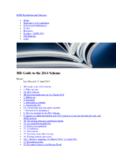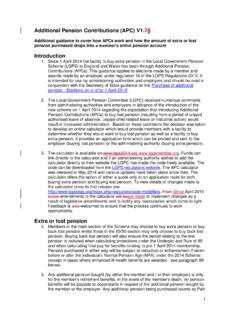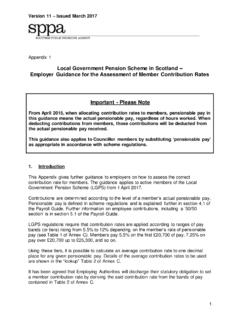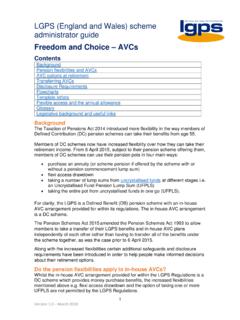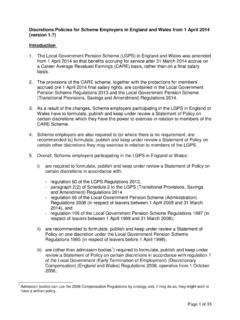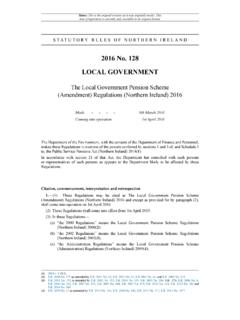Transcription of the member’s ‘protected’ Normal - lgpslibrary.org
1 1 Dealing with the 85 year rule in the 2014 Scheme ( ) Groups Group 1 member: a member who was an active member at any time between 1 April 1998 and 30 September 2006 and who was born on 31 March 1956 or earlier Group 2 member: a member who was an active member at any time between 1 April 1998 and 30 September 2006, was born between 1 April 1956 and 31 March 1960 inclusive, and who would reach their CRA by 31 March 2020 Group 3 member: a member who was an active member at any time between 1 April 1998 and 30 September 2006 and who is not a Group 1 or Group 2 member Group 4 member: a member who was not a member prior to 1 October 2006.
2 CRA = the earlier of a) the member s pre 1 October 2006 protected Normal Retirement Date which some members who joined the Scheme before 1 April 1998 had under regulation 25(3A) of the lgps regulations 1997 before its deletion by SI 2006/966 b) the earliest date at which the member would have satisfied the 85 year rule had the member remained in service, calculated in accordance with paragraph 4 of Schedule 2 to the lgps (Transitional Provisions, Savings and Amendment) regulations 2014 c) age 65 BUT CRA cannot be earlier than 60 for voluntary early retirements under Regulation 30(5) of the lgps regulations 2013 unless the employer has agreed, under paragraph 1(1)(c) of Schedule 2 to the lgps (Transitional Provisions, Savings and Amendment) regulations 2014, that it should be.
3 2008 Scheme In the table on page 9 of the GAD guidance at we show that the actuarial reduction under the 2008 Scheme was as follows: Group 1 Group 2 Group 3 Group 4 Part A CRA CRA CRA 65 Part B CRA Taper 65 65 Part C 65 Taper 65 65 Part D 65 65 65 65 Part A = membership to 31 March 2008 Part B= membership 1 April 2008 to 31 March 2016 Part C = membership 1 April 2016 to 31 March 2020 2 Part D = membership 1 April 2020 onwards 2014 Scheme A member s CRA under the 2008 Scheme is cast in stone. Thus, if a member could not meet the 85 year rule by age 65, that member s CRA is age 65.
4 A member retiring at 66 who would meet the 85 year rule at 65 would still have a protected CRA of 65. Thus, if that member retires at age 60 they will, on their protected membership, have an actuarial reduction for retiring 5 years earlier than their CRA (60 65) and not an actuarial reduction for retiring 5 years early. The CRA cannot be later than age 65. For membership from 1 April 2016 to 31 March 2020 the taper for a Group 2 member should be applied to the Normal actuarial reduction for retirement prior to age 65 (not SPA).
5 This could mean that there will be cases where a Group 2 member retiring between 1 April 2016 and 31 March 2020 will have a lesser actuarial reduction applied than a Group 1 member (whose membership after 31 March 2016 will have an actuarial reduction applied based on the shortfall to SPA). The table for the 2014 Scheme now reads as follows: Group 1 Group 2 Group 3 Group 4 Part A CRA (can t be later than 65) CRA (can t be later than 65) CRA (can t be later than 65) 65 Part B1 CRA (can t be later than 65) Taper (proportion of Normal % reduction to 65) 65 65 Part B2 CRA (can t be later than 65) Taper (proportion of Normal % reduction to 65) SPA (min 65) SPA (min 65) Part C SPA (min 65) Taper (proportion of Normal % reduction to 65) SPA (min 65) SPA (min 65) Part D1 SPA (min 65) SPA (min 65) SPA (min 65) SPA (min 65)
6 Part D2 65 65 65 65 Part A = membership to 31 March 2008 Part B1= membership 1 April 2008 to 31 March 2014 Part B2 = membership 1 April 2014 to 31 March 2016 Part C = membership 1 April 2016 to 31 March 2020 Part D1 = membership 1 April 2020 onwards (including Part D1 benefits as defined in the notes at the end of this paper) Part D2 = membership defined as D2 membership (including Part D2 benefits as defined in the notes at the end of this paper). Members with an Underpin addition 3 Where a member s pension being brought into payment includes an underpin guarantee amount , both a) the underpin guarantee amount , and b)
7 The amount of the pension in the member s post-14 pension account accrued prior to the member s 2008 NPA, but excluding any element of that post-14 pension account which was derived from a transfer in or which relates to an APC / SCAPC (other than where the APC / SCAPC was to cover a period of absence from work with no pensionable pay in consequence of a trade dispute or to cover a period of authorised unpaid leave of absence, including a period of unpaid additional maternity, paternity or adoption leave or unpaid shared parental leave) are treated as if they were pension accrued under the 2008 Scheme for the purposes of determining any actuarial reduction (or increase) due on them.
8 Any underpin guarantee amount which is calculated will need to be apportioned to Part B2, Part C and Part D2 as appropriate in order that the correct actuarial reduction can be applied (if drawn before the member s NPA under the 2008 Scheme). For example, if the member has membership from 1 April 2014 to 31 March 2021 (7 years), has final pay (2008 Scheme definition) of 40,000 and has an underpin guarantee amount of the underpin amount would be allocated as follows: B2 C D2 2014/15 2015/16 2016/17 2017/18 2018/19 2019/20 2020/21 CARE accrued Total CARE 1, 2, 2008 Scheme comparison 2/60 x 40,000 = 1, 4/60 x 40,000 = 2, 1/60 x 40,000 = Difference - + + Total 1, 2, This method of allocation ensures that where a member is subject to the 85 year rule the actuarial reduction applicable to Part B2.
9 Part C and Part D2 membership is applied to the amount of pension the member would actually have earned as Part B2, Part C or Part D2 membership had they remained in the 2008 Scheme. Furthermore c) any element of the member s post-14 pension account which was derived from a transfer in or which relates to an APC / SCAPC (other than where the APC / SCAPC was to cover a period of absence from work with no pensionable pay in consequence of a trade dispute or to cover a period of authorised unpaid leave of absence, including a period of unpaid additional maternity, paternity or adoption leave or unpaid shared parental leave)
10 4 is treated as pension accrued under the 2014 Scheme for the purposes of determining any actuarial reduction (or increase) due on them (related to the member s NPA in the 2014 Scheme). The rationale for (c) is twofold. Firstly, regulations 4(5)(b)(i), 4(5)(c) and 4(5)(d) of the lgps (Transitional Provisions, Savings and Amendment) regulations 2014 exclude the elements in (c) from the underpin calculation (and so they must, therefore, be paid in addition). Secondly, the amount of pension credited to the member s account from a transfer in and the amount of the additional pension purchased via the APC / SCAPC were based on the member s NPA under the 2014 Scheme.



